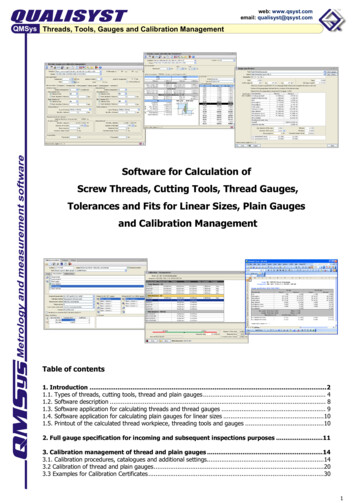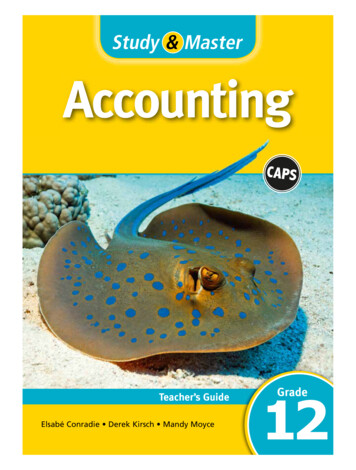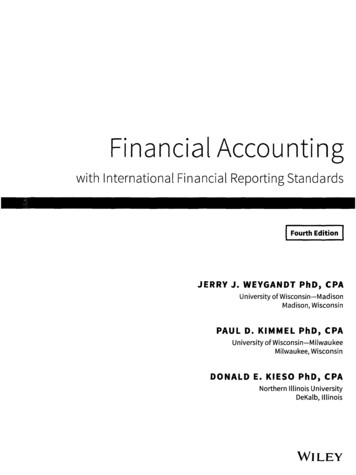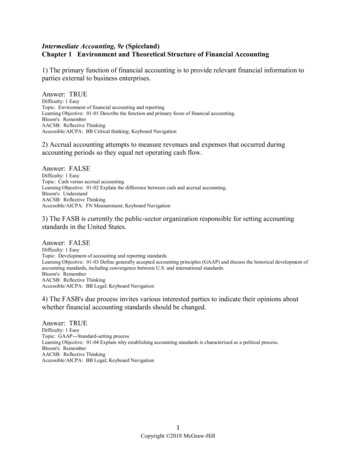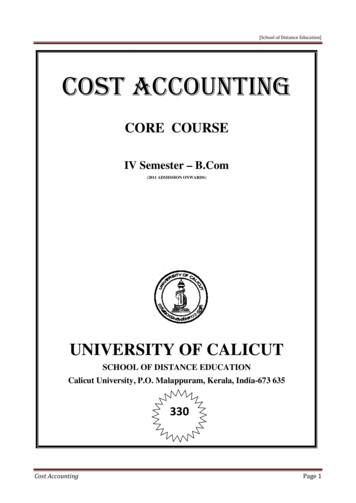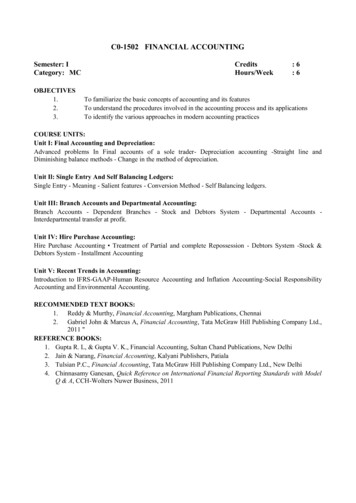
Transcription
C0-1502 FINANCIAL ACCOUNTINGSemester: ICategory: MCOBJECTIVES1.2.3.CreditsHours/Week:6:6To familiarize the basic concepts of accounting and its featuresTo understand the procedures involved in the accounting process and its applicationsTo identify the various approaches in modern accounting practicesCOURSE UNITS:Unit I: Final Accounting and Depreciation:Advanced problems In Final accounts of a sole trader- Depreciation accounting -Straight line andDiminishing balance methods - Change in the method of depreciation.Unit Il: Single Entry And Self Balancing Ledgers:Single Entry - Meaning - Salient features - Conversion Method - Self Balancing ledgers.Unit III: Branch Accounts and Departmental Accounting:Branch Accounts - Dependent Branches - Stock and Debtors System - Departmental Accounts Interdepartmental transfer at profit.Unit IV: Hire Purchase Accounting:Hire Purchase Accounting Treatment of Partial and complete Repossession - Debtors System -Stock &Debtors System - Installment AccountingUnit V: Recent Trends in Accounting:Introduction to IFRS-GAAP-Human Resource Accounting and Inflation Accounting-Social ResponsibilityAccounting and Environmental Accounting.RECOMMENDED TEXT BOOKS:1. Reddy & Murthy, Financial Accounting, Margham Publications, Chennai2. Gabriel John & Marcus A, Financial Accounting, Tata McGraw Hill Publishing Company Ltd.,2011 "REFERENCE BOOKS:1. Gupta R. L, & Gupta V. K., Financial Accounting, Sultan Chand Publications, New Delhi2. Jain & Narang, Financial Accounting, Kalyani Publishers, Patiala3. Tulsian P.C., Financial Accounting, Tata McGraw Hill Publishing Company Ltd., New Delhi4. Chinnasamy Ganesan, Quick Reference on International Financial Reporting Standards with ModelQ & A, CCH-Wolters Nuwer Business, 2011
C0-1503 BUSINESS ENVIRONMENT & ETHICSSemester: ICategory: MCObjectives:1.2.3.CreditsHours/Week:3:3To provide an overview of Business Environment in IndiaTo help analyse, and appreciate, the importance of key environmental factorsTo understand the elements of global business environment and its implicationUnit 1: Business Environment-An overviewNature & Scope of business - Business Environment - Types - Micro & Macro Environment - EnvironmentalAnalysis & Strategic Management process- Importance & limitations-Approaches to EnvironmentalAnalysisUnit 2: Economic EnvironmentFeatures and Functions of Economic System - Types of Economic System - Merits, Demerits & Comparison- Brief history planning in India – 11th and 12th five year Plans In India -Economic Parameters - Descriptionof indices: Corruption perception index, Micro economic competitiveness index, Technology index.Unit 3: Political EnvironmentConstitutional Environment - Features - Fundamental Rights & Duties- Functions & Economic Roles of theState- Consumer Protection Act - Environment Protection Act - Competition ActUnit 4: Social & Cultural EnvironmentDemographic Environment - Culture & Business - Impact of foreign culture on business - Business &Society -Business Ethics- Social Responsibilities of business towards different groupsUnit 5: Global EnvironmentGlobalisation- Meaning & rationale for Globalisation-Role of WTO & GATT - Trading blocks inGlobalisation - Impact of Globalisation on IndiaCOURSE TEXTSGupta C.B., Business Environment, Sultan & Chand Publications, New DelhiCOURSE REFERENCES1. Francis Cherunilam, Business Environment, Himalaya Publishing House, Mumbai2. Sankaran, Business Environment, Margham Publications. Chennai
CO-2502 BUSINESS MANAGEMENTSemester: IICategory: MCCreditsHours/Week:6:6Objectives:1. To enable the students to understand and appreciate the contribution made by management thinkers.2. To familiarize students with the principles, functions and techniques used to effectively managebusiness enterprises.3. To provide opportunities to apply the general functions of management in day-to-day managerialpracticeCOURSE UNITS:Unit I: Introduction to Management:Definition & Meaning of management- Functions of Management -Managerial skills - levels of management- roles of manager, Management as a Science or Art -Approaches to Management - Contribution tomanagement by F.W.Taylor, Henry Fayol, Elton Mayo and Peter F. Drucker, C. K. Prahalad.Unit II: Planning:Planning - importance - Process of planning - types of planning - planning methods (Objectives- PoliciesProcedures - Strategies & Programmes) - Obstacles to effective planning. Decision making - Steps - Types Decision TreeUnit Ill: Organising:Organization - Importance - Principles of Organizing. Delegation & Decentralization – Departmentation Span of Management. Organizational structure - line & staff and functional - organizational charts andmanual -making organizing effective - Staffing - recruitment -selection - Training, promotion and appraisal.Unit IV: Directing:Function of directing - Motivation - Theories of motivation (Maslow, Herzberg and Vroom's theories)Motivation techniques. Communication - Function - Process - Barriers to effective communication.Leadership- Definition- Theories and approach to leadership- styles of leadership -TypesUnit V: Co-ordination and Control:Nature - Problems of effective coordination. Control - Nature - Basic control process - control techniques(traditional and non- traditional)-Use of Computers in managing information.RECOMMENDED TEXT BOOKS:Gupta C. B, Business Management, Sultan Chand & Sons, New Delhi, 2011REFERENCE BOOKS:1. Koontz, O'Donnell, Weirich, Essentials of Management, Tata McGraw Hill Publishing Company Ltd.,New Delhi, 5th Edition, 19982. Pagare Dinkar, Principles of Management, Sultan Chand & Sons, New Delhi, 2003.3. Sherlekar & Sherlekar, Principles of Business Management, Himalaya Publishing House, New Delhi,2000
CO-2503 BUSINESS LAW –ISemester: IICategory: MCCreditsHours/Week:3:3Objectives:1. To help the students to learn the elements of general contract2. To understand the various contracts In business or professionUNIT-I: NATURE OF CONTRACTObject of Law of Contract-The Indian Contract Act 1872-meaning and definition of contract-essentialelements of a valid contract- Classification of contracts.UNIT-Il: OFFER, ACCEPTANCE AND CONSIDERATIONOffer- meaning-definition-rules relating to offer-tenders-cross and counter offer.Acceptance-meaning and definition, who can accept? - legal rules as to acceptance-communication offer andacceptance- revocation of acceptance-revocation of offer and acceptance. Consideration-meaning-definitionlegal rules relating to consideration-stranger to contract and consideration-contracts without considerationUNIT-III: CAPACITY TO CONTRACT, FREE CONSENT AND LEGALITY OF OBJECTMinors-rules relating to agreements with minors-persons disqualified by law to enter Into valid contactpersons of unsound mind-Free consent- Meaning and definition of consent and free consent-coercionEssentials of Coercion-fraud-Essentials of fraud-Misrepresentation- essentials of misrepresentationDifference between fraud and misrepresentation-undue influence Difference between undue influence andfraud.-essentials of undue influence-mistake-types of mistakes. Legality of object-When is consideration orobject unlawful and illegal agreements opposed to public policyUNIT-IV: QUASI AND CONTINGENT CONTRACTSQuasi contracts-Meaning and Definition, Types of Quasi Contracts. Contingent contracts-Meaning andDefinition- Rules regarding Contingent ContractsUNIT-V: PERFORMANCE OF CONTRACTSMeaning and definition-offer to perform-contracts which need not be performed-Devolution of joint rightsand liabilities-persons allowed to demand for the performance-time and place of performance-performanceof reciprocal promises-time as the essence of contract-appropriation of payments-assignment of contracts.TEXTBOOK:1. KAPOOR N.D, Elements of Mercantile Law, Sultan Chand & Sons, New DeIhi-20102. BALACHANDRAN V, & THOTHARDI, Business Law, Tata McGraw Hill Publishing Company Ltd.,2010REFERENCE BOOKS:1. Shukla M. C., Mercantile Law, Vikas Publishing House. New Delhi- 20102. Shukla M.C., Mercantile Law, Sultan Chand & Sons, New Delhi- 2009
CO 3502COMPANY ACCOUNTS(Applicable for B.Com Students admitted from June 2012)SemesterCategory: III: MCCredits:6Hours / Week : 6Course Objectives:1. To familiarize students with the accounting treatment for issue of shares and debenture to run thecompany with long term source of funds.2. To enable students to prepare the financial statements of Joint Stock Companies.3. To understand the procedure for valuing the goodwill and shares of Companies to acquire abusinessUnit 1: SHARESIssue of Shares –Under-Subscription and Over-Subscription - Pro-rata Allotment – Forfeiture & Reissue ofShares–Rights Issue - Sweat Equity - Stock to Invest - Lien on Share - Buy Back of Share - Accounting forBonus Shares – Issue of Debenture for cash and kind only-Underwriting of Shares and Debentures- Markedand Unmarked Applications–Firm Underwriting.Unit II : PREFERENCE SHARESMeaning – Guidelines for Issue and Redemption of Preference Shares- Redemption at Par and at Premium Redemption out of Revenue reserve and out of Fresh Issue - Bonus Issue out of Capital Redemption Reserve.Unit III: FINANCIAL STATEMENTSObjectives of Financial Statements –Preparation and Presentation of Financial Statements of Joint StockCompanies; Form and Contents of Profit & Loss Account and Profit & Loss Appropriation AccountCalculation of Managerial Remuneration - Form of Balance Sheet – Report to be attached-Preparation ofCash Flow Statement (AS-3).Unit 4: ACQUISITION OF BUSINESS AND PROFIT PRIOR TO INCORPORATION.Acquisition of Business- Reason for Converting into a Company- Accounting Treatment -New Sets of Books–Same Set of Books-Vendors’ Suspense Accounts. Profit Prior to Incorporation–Meaning-Calculation ofTime Ratio– Sales Ratio-Determination and Treatment of Pre-Incorporation and Post-Incorporation ProfitsUnit 5: VALUATION OF GOODWILL AND SHARES AND INTERNAL RECONSTRUCTIONMeaning of Goodwill– Factors Affecting Valuation of Goodwill-Need and - Methods of Valuation ofGoodwill; Valuation of Shares- Need and Methods of Valuation of Shares- Alteration of Share Capital ofCompany – Internal Reconstruction –Accounting Treatment of Reduction of Share Capital.COURSE TEXTS1. Joseph T., Corporate Accounting- Vol.1, Tata McGraw Hill, 20092. Reddy & Murthy, Corporate Accounting, Margham Publications, Chennai, (2008)COURSE REFERENCES1. Gupta R.L. & Radhasamy, Corporate Accounting, Sultan Chand Publications, New Delhi, 20082. Shukla M.C.& Grewal T.S., Corporate Accounting, Chand & Co., Publications, New Delhi, 20083. Pillai R.S.N., Bhagawathi, S. Uma, Fundamentals of Advanced Accounting, Vol.-II, S. Chand, NewDelhi-2007
CO-3503BUSINESS LAW-IISemester: IIICategory: MCCredits:Hours / Week:66COURSE OBJECTIVES1. To help students understand the legal aspects of special contracts.2. To equip students to understand and deal with various contracts both in Business and Profession.UNIT-I: CONTRACT OF INDEMNITY AND GUARANTEE, CONTRACT OF BAILMENT ANDPLEDGEIndemnity: Essential Features of contract of indemnity- -distinction between indemnity and guarantee-kindsof guarantee-Rights of indemnity holder -Time of commencement of indemnifier’s liability-duties andliabilities of surety -discharge of surety. Bailment: Meaning-Classification-duties and rights of bailor andbailee- difference between bailment and pledge-rights and duties of pawnor and pawnee.UNIT-II: CONTRACT OF AGENCY & DISCHARGE OF CONTRACTAgency: Definition of principal and agent - creation of agency- classification of agents- relationship betweenprincipal and agent- rights and duties of principal and agent -relationship between the principal and thirdparties- liability of agent-termination of agency. Meaning of Discharge, Breach & remedies of Contract.UNIT-III: SALE OF GOODS ACTSale of goods-agreement to sell-sale and hire purchase agreement-sale and bailment-sale and contract forwork and materials-subject matter of contract of sale –document of title to goods- price-stipulations to timecondition and warranties- caveat emptor-transfer of property- sale by non-owners-exceptions- delivery ofgoods-rules as to delivery of goods- rights and duties of the buyer-unpaid seller-rights of Unpaid sellerauction sales.UNIT-IV: CARRIAGE OF GOODS ACTCarrier: classification of carriers- common carrier - duties and rights of common carrier -goods--contract ofaffreightment-charter party-bill of lading- carriage by rail, sea, air-documentation.UNIT-V: THE CONSUMER PROTECTION ACT, 1986Definitions-Objects-central and state consumer protection council-consumer disputes-redressal agenciesforum-consumer disputes redressal commission-State and National LevelsTEXT BOOKS:1. KAPOOR.N.D., Elements of Mercantile Law, Sultan Chand & CO, New-Delhi, 20112. BALACHANDRAN.V & THOTHARDI, Business Law, Tata McGraw Hill Education Private Ltd,2010REFERENCE BOOKS:1. Kuchal, Mercantile Law, Vikas Publishing House, New Delhi, 2010.2. R.S.N.Pillai & Bagavathi, Mercantile Law, Sultan Chand &Sons- New Delhi-2010.
CO 4504 COMPANY LAWSemesterCategory: IV: MCCredits:6Hours / Week : 6Course Objectives1. To help students to understand the significant provisions of the Companies Act.2. To introduce students to the formation process of a company.3. To expose students to the main charter of a company and the raising of capital in a company.UNIT 1: COMPANY LAW – AN OVERVIEWCompany – Definition–Characteristics– Lifting the corporate veil – Advantages of IncorporationCompany Law Administration – National Company Law Tribunal & Appellate tribunal–UNIT II – KINDS OF COMPANIESClassification on the basis of incorporation – On the basis of members - Private and Public - Privileges ofprivate company – private and public company distinguished – On the basis of liability – On the basis ofownership - Government company -Foreign company – On the basis of control - Holding and Subsidiarycompany - Producer companiesUNIT III - FORMATION OF COMPANYFormation of company -Preliminary contracts – Certification of Incorporation -Promotion - Certificate ofcommencement o Business– Promoters– Functions & Legal Status - MCA 21 – Scheme for filing statutorydocuments & other transactions by companies through electronic mode – Features of MCA 21.UNIT IV – MEMORANDUM AND ARTICLES OF ASSOCIATIONMemorandum of Association - Nature and Contents - Alteration of memorandum - Doctrine ofultravires - Articles of Association - Purpose and Content -Alteration of articles - Doctrine of constructivenotice and indoor managementUNIT V – RAISING SHARE CAPITALProspectus – Definition – Registration - Contents – Shelf Prospectus – Deemed prospectus –Statement inlieu of prospectus - Misstatement and their consequences – Share Capital – Meaning –Kinds – Alteration ofshare capitalCOURSE TEXTS1. Kapoor N,D, Company Law& Secretarial Practice , 13th Ed., Sultan Chand & Sons, New Delhi, 20092. Srinivasan, Company Law and Secretarial Practice, Margam Publications, Chennai, 2005COURSE REFERENCES1.Pillai R.S.N. & Bhagwathi, Business Law, S. Chand & Co., New Delhi, 20032. Majumdhar A.K and Kapoor G.K, Company Law and practice, Nabhi publications, New Delhi, 2003
SemesterCategory: IV: MCCO-4505COST ACCOUNTINGObjective:1. To familiarise the students on the importance of cost ascertainment,Credits:6Hours / Week : 6reduction and control.2. To develop the skills needed to apply costing technique for each element of cost3. To help students to understand the procedures to calculate the cost of theproductsandservicesUnit II: INTRODUCTION & MATERIALS CONTROLCost accounting: Objectives - Classification of Costs – Cost Unit – Cost Centre- Elements of Cost Financial Accounting vs. Cost Accounting – Steps in installing a Cost Accounting system Material Control:Purchasing – Centralised Vs Decentralised - Store Keeping – Stock level determination – EOQ & ABCAnalysis – Purchase price computation - Treatment of Scrap, Spoilage, Wastage & Defectives - Pricing ofissue of material – FIFO, LIFO & Weighted Average methodsUnit II: LABOUR COSTLabour Costing & Control – Payroll Accounting – Treatment of Idle time & Over time – Methods of Wagepayments - Piece Rate – straight – differential piece rate - Taylor’s differential piece rate, Merrick’s Multiplepiece rate – Time rate - Incentive Methods – Halsey incentive scheme, Rowan Plan, Group IncentiveScheme- Labour Turn Over –Causes, effects and preventionUnit III: OVERHEADSOverheads – classification, Allocation, Apportionment - Redistribution of overheads - Absorptions –methods of absorption - Machine hour rate – Activity based CostingUnit IV: COST SHEETCost Sheet format-Unit, Job and Batch Costing- Preparation of Cost Sheet, Tender & Quotation –Reconciliation of profits as per Cost & Financial AccountsUnit V: METHODS OF COSTINGContract costing – Operating Costing (Transport only) – Process Costing –Valuation of Work-in-progress –Accounting for Joint & By-productsCourse TextMurthy & Gurusamy S, Cost Accounting, Tata McGrawHill, 2010Maheswari S.N., Principles of Cost Accounting, Sultan Chand Publications, New Delhi, 2010Course ReferencesReddy T.S. & Hari Prasad Reddy Y., Cost Accounting, Margham Publications, Chennai, 2012Jain S.P & Narang K. L., Cost Accounting, Kalyani Publications, New-Delhi, 2012Saxena V. K. & Vashist C. D., Cost Accounting, Sultan Chand & Company, New-Delhi, 2009
CO-4506SemesterCategoryENTREPRENEURSHIP AND OPPORTUNITY ANALYSIS: IV: MCCredits:2Hours / Week : 3Course Objective:1. To enable the students to understand the concept of Entrepreneurship and to learn the professionalbehavior about entrepreneurship2. To identify significant changes and trends which create business opportunities and to analyze theenvironment for potential business opportunities3. To provide conceptual exposure on converting idea to an entrepreneurial firmUnit I: Entrepreneurship:Entrepreneur: Meaning of Entrepreneurhip- Types of Entrepreneurs- Traits of entrepreneur- Intrapreneur Factors promoting entrepreneurship, Barriers to entrepreneurship. The entrepreneurial Culture; Stages inentrepreneurial process- International Entrepreneurship Opportunities: The nature of internationalentrepreneurshipUnit II: Developing successful Business ideas:Recognizing opportunities – trend analysis - generating ideas - Brainstorming, Focus Groups, Survey,Customer advisory boards, Day in the life research- Encouraging focal point for ideas and creativity at thefirm level. Protecting ideas from being lost or stolenUnit III: Opportunity Identification and Evaluation:Opportunity identification and selecting the product / service – Generation and screening the project ideas–Market analysis, Technical analysis, cost benefit analysis and net work analysis. Project formulation –Assessment of project feasibility. Dealing with basic and initial problems of setting up of EnterprisesUnit IV: Business Planning Process:Meaning of business plan, Business plan process, Advantages of business planning, preparing a modelproject report for starting a new ventureUnit V: Funding:Sources of Finance, Venture capital, nature, venture capital process, Business Angels, Commercial banks,Government GrantsTEXT BOOKS:1. Barringer Bruce R., Ireland R. Duane, Entrepreneurship - Successfully Launching New Ventures,Pearson Education, 2008.2. Khanka S.S., Entrepreneurial Development, S.Chand & Co. Ltd., New Delhi, 1999.REFERENCE BOOKS:1. David Holt, Entrepreneurship – New Venture Creation, Prentice Hall of India, New Delhi, 2000.
2. Gupta.C.B. & Khanka S.S., Entrepreneurship and Small Business Management, Sultan Chand &Sons, 2010.3. Hisrich Robert D, Peters Michael P, Shepherd Dean A, Entrepreneurship, 6th Edition, The McGrawHill Companies, 20074. Gupta C. B., Srinivasan N P, Entrepreneurial Development, Sultan Chand and Sons, 19925. Kurakto, Entrepreneurship-Principles and practices, 7th Edition, Thomson publication, 20076. Weihrich Heinz, Canice Mark V and Koontz Harold, Management – A Global and EntrepreneurialPerspective, Tata McGraw Hill Education Pvt. Ltd., 3rd Edition, 2011.CO 5504 INCOME TAX LAW AND PRACTICESemesterCategory:V: MCCredits:6Hours / Week : 6Course Objectives1. To impart knowledge of the basic principles of income tax law to the students.2. To equip students with the application of income tax under various heads of income1. To familiarize students with provisions of Income tax law for tax planningUnit 1: RESIDENTIAL STATUSMeaning of Income – Basis of Charge – Basic Concepts – Residential Status of Persons – Incidence of TaxUnit 2: INCOME FROM SALARYIncome under the head Salaries – Forms of salary - Allowances – Perquisites – Deductions u/s 80 – TaxRebate – provident Funds – Computation of Salary IncomeUnit 3: INCOME FROM HOUSE PROPERTYIncome from House Property – Annual Value – Deductions u/s 24 – Computation of income from let outHouses and self Occupied HouseUnit 4: PROFITS AND GAINS OF BUSINESS OR PROFESSIONProfits and Gains of Business or Profession – Chargeability – Admissible deductions – Inadmissibleexpenses – Computation of Business Income (Excluding Firms and Companies) – Computation Income fromProfessionUnit 5: CAPITAL GAINS & OTHER SOURCESCapital gains – Definition of Capital Assets – Kinds – Exempted Capital Gains – taxability of capital gains Computation of - Income from other Sources – Computation of taxable income of individualCourse Text (Current Edition)Vinod Singhania K. & Monica Singhania, Students Guide to Income Tax, Taxman Publications, 2012Course References (Current Edition)1. Gaur V.P., and Narang D.B., Income Tax Law and Practice, Kalyani Publishers2. Mehrotra & Dr. Goyal, Income Tax Law and Practice, Sahitya Bhawan Publications
CO-5505 PRINCIPLES OF MARKETINGSemesterCategory:V: MCCredits:6Hours / Week : 6Course Objectives1. To expose students to the importance of Marketing in the Business World.2. To enable students to understand the elements of the Marketing Mix.UNIT I: Marketing and the Marketing ProcessDefinition of Marketing and Marketing Management – Marketing Process – Marketing ManagementOrientation – Marketing Plan – Marketing Mix – Relationship Building – Customer Retention StrategiesUNIT II: Consumer/ Business Market SegmentationMarketing Environment – Managing Marketing Information – Consumer Markets -Consumer BuyerBehaviour Process – Business Markets - Business Buyer Behaviour Process – Market Segmentation –Targeting – Positioning StrategiesUNIT III: Product and Pricing StrategiesProduct, Services and Branding Strategies – Types of Products – Product Mix – New Product Development– Product Life Cycle Strategy, Pricing – Pricing Objectives - Kinds of Pricing – Factors Affecting Pricing –Pricing StrategiesUNIT IV: Marketing Channel and Communication StrategiesMarketing Channels – Functions – Types – Event Management - Channel design management – Channelbehavior – Organisation and Conflict; Marketing Communication Mix – Communication Process – Steps inDeveloping Effective Marketing Communication – Setting Promotion Budget and MixUNIT V: Contemporary IssuesCompetitor Analysis and Strategies – Social Responsibility and Ethics – Citizen and Public Actions toRegulate Marketing –Recent Trends in Marketing: Marketing Intelligence – Social Media – Digital Media –Sight Engine Optimization – Search Engine ManagementCourse Text:Kotler Philip, Armstrong Gary, Agnihotri y. Prafulla, Ehsan Ul Haque, Principles of Marketing -A SouthAsian Perspective, 13th Edition, Pearson 2009.Course References:1.Maheshwari P. Rajendra, Principles of Marketing, International Book House, 1st edition, 2012.2. Armstrong Gary, Kotler Philip, Principles of Marketing, Prentice Hall, 2011.
CO 5506 HUMAN RESOURCE MANAGEMENTSemesterCategory:V: MCCredits:6Hours / Week : 6Course Objectives1. To highlight the importance of HRM in an organisation2. To familiarise the students with the processes and mechanism of managing human resources3. Understand how Human Resources can become a competitive advantage in organisationsUNIT 1: INTRODUCTIONHRM – importance – Characteristics – Operational area of HRM – Qualities of a good HR Manager –Changing roles of HR Managers – Difficulties and challenges faced by HR managers – recent trends in HRUNIT II: HUMAN RESOURCE PLANNINGConcept of HR planning – Characteristics – Steps in HR planning – HR Capital - Job Analysis – SuccessionPlanning – Auditing of HR resources - ERP technologies - Preparation of HR planning –Dealing with surplusand deficit human resource – Attrition management & retention managementUNIT III: TALENT ACQUISITIONDefinition – Objectives – Factors affecting recruitment – internal and external source of recruitment –Selection Process –Types of Testing – Kinds of employment interview – Medical Screening – AppointmentOrderUNI IV: LEARNING AND DEVELOPMENTDefinition and purpose of training – Distinction between training and development – Assessing trainingneeds – Steps in training – On the job and Off the job training – Evaluation of training effectiveness –Developing Competency – Stages of Competency – Competency Management – Mentoring and CoachingUNIT V PERFORMANCE APPRAISALObjectives of appraisals – Steps in appraisals - Traditional and Non-traditional methods of performanceappraisals - Managing grievances & disciplineCourse Texts:1. Gupta C.B, Human Resource Management, Sultan Chand and Sons, 14th Edition, New Delhi, 20122. Aswathappa K, Human Resource Management, 6th Edition, Tata McGraw-Hill Education Pvt. Ltd, 2010Course References:1.Jyothi P & Venkatesh D.N, Human Resource Management , Oxford University Press, New Delhi,20062.Mamoria C.B, & Rao V. S. P, Personnel Management (Text and Cases), Himalayan Publications,New Delhi, 20123.Wayne Mondy Robert, Human Resource Management, Pearson Education, 12th Edition, New Delhi,2010
CO 5507 INDIAN BANKINGSemesterCategory:V: MCCreditsHours / Week:6:6Course Objectives:1.To familiarise students with the functions of commercial banks2.To expose the credit control measure of RBI to the students3.To update students with the changing trends in banking industryUnit 1: Introduction To BankingMeaning, definition and - Functions of commercial banks – importance of Credit creations –Classificationof banks - Cooperatives banks – Regional Rural Banks – Investment Banks - Retail and InternationalBanking - Role of Banking in the Economic Development of a CountryUnit 2: Reserve Bank Of IndiaEstablishment – Legal framework - Departments and offices - Licensing of Banks - Capital PrudentialRegulations and Requirements - Functions of RBI – Credit control – Need for credit control– Qualitativeand quantitative measures - CRR, Bank Rate, SLR, Repo Rate, Reverse Repo Rate and other credit controlmethods.Unit 3: Banker-CustomerBanker-Customer relations - Know your Customer (KYC) guidelines - services rendered by Banks Mandate and Power of Attorney - Banker’s lien - right of set off - garnishee order - Income tax attachmentorder etc. - Payment and collection of Cheque - duties and responsibilities of paying and collecting bankerprotection available to paying and collecting banker under NI Act - endorsements - forged instruments bouncing of cheques and their implications - Endorsement Crossing - Types of Crossing and EndorsementsUnit 4: Banking ProductsDifferent Deposit Products – secured – unsecured ; Lending by banks - Policies - Forms of Advances –Loan - Overdrafts - Cash Credit - Secured & unsecured Advances - General Principles – precaution –Various Modes of Creating Charge - Lien - Pledge - Hypothecation - Mortgage - Securities for advances– types of loanUnit 5:Recent Banking practicesE-Banking - Core Banking - Automatic Teller Machine (ATM) - Debit and Credit Cards– White-labelATM - Real Time Gross Settlement (RTGS), National Electronic Fund Transfer (NEFT), - Meaning,Differences - Banking OmbudsmanCourse TextSundharam K.P.M. & Varshney P.N., Banking Theory, Law & Practice, Sultan Chand & Sons, 2010Course Refernces1. Gordon E & Natarajan K, Banking Theory Law and Practice, Himalaya Publishing House, 20122. Gupta R.K., Banking Law and Practice, Wadhwa Book Company, 20113. Shelagh Heffernan, Modern Banking, Wiley; 2nd edition, 2005
CO 5404 INTRODUCTION TO INVESTMENT MANAGEMENTSemesterCategory:V: ESCredits:2Hours / Week : 3Course Objectives1.To help students to realise the significance of personal financial planning2.To help students to understand the relationship between risk and return in investment3.To familiarize the students with various investment avenues available in IndiaUnit 1: IntroductionInvestment –Objectives of investment – Investment versus Speculation - Investment Process – InvestmentInformation – Personal Financial Planning – Risk profilingUnit 2: Time Value Of MoneyMeaning - Current money Vs. Future money – Present Value Interest Factor – Present Value Interest FactorAnnuity – Future Value Interest Factor - Future Value Interest Factor Annuity – Calculation of Time Valueof MoneyUnit 3: Risk & ReturnRisk - Systematic & Unsystematic Risks - Calculation of risk –Probability & Non-Probability risks Return – Capital & Revenue returns - Calculation of return – Equity and Bond valuationUnit 4: Investment AlternativesBank Deposits – Post Office Savings Schemes - NBFC Deposits – Gold & Silver – Real Estate – EquityShares & Debts – Bonds & Government Securities – Mutual Funds – Life Insurance & Tax SavingsInstruments - Derivatives – Modern InvestmentsUnit 5: Investment AnalysisPrimary Market versus Secondary MarketAnalysis - Company Analysis -- Fundamental Analysis- Economic Analysis – IndustryCourse Text:Rustagi R.P, Investment Analysis & Portfolio Management, Sultan Chand & Sons., New Delhi, 2011Course Reference:1.Natarajan, Investment Management, Margham Publishers, Chennai, 20122.Pandian Punithavathi, Security Analysis and Portfolio Management, Vikas Publishers, New Delhi,20103.Chandra Prasanna, Investment and Portfolio Management, Tata McGraw-Hill, New Delhi, 2011
CO 5405 FINANCIAL SERVICESSemesterC
Introduction to IFRS-GAAP-Human Resource Accounting and Inflation Accounting-Social Responsibility Accounting and Environmental Accounting. RECOMMENDED TEXT BOOKS: 1. Reddy & Murthy, Financial Accounting, Margham Publications, Chennai 2. Gabriel John & Marcus A, Financial Accounting
